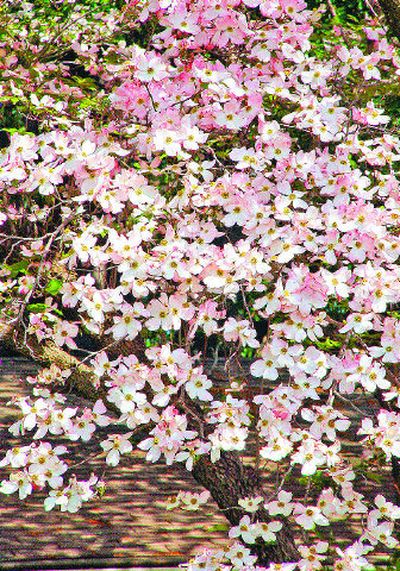Dogwoods get their day in the sun

The dogwood trees around this area outdid themselves this year. There were huge pink and white clouds everywhere!
The most popular dogwoods found in local gardens are the Florida dogwoods (Cornus florida) that are native to the forests of the eastern U.S. As a young plant, its branches grow quite upright and with age they begin to grow out horizontally, creating a beautiful layered structure that makes the tree interesting year round. The tree holds its leaves in tight, curved clusters along the top of the branch, adding to the textural interest especially when the wind shows off the grayish white underside of the leaves. In the fall, they turn to subtle but striking shades of red and burgundy. The trees can grow to 20 feet high and wide.
The flowers bloom from white to shades of light pink to almost a red, depending on the cultivar. One of the reasons they are so stunning is that the tree blooms before the leaves come out so that flowers are all you see. But the “flowers” we see aren’t really flowers; they are modified leaves called bracts that surround the inconspicuous yellow flowers at the center of the cluster of four bracts.
The trees need a well drained humus-rich soil and regular deep watering especially during the drier part of the summer. They can be planted in full sun as long as it is away from walls and large rocks that hold a lot of heat. They do well in morning sun with some shade from the hot afternoon sun. Trees planted in too much shade will grow more quickly but flower less. It can take several years for a young tree to begin blooming. Dogwoods do not need any pruning, as they grow slowly and their natural shape is one of their hallmarks.
The Florida dogwoods are at their hardiness limit (USDA Zone 5) here. Even then that hardiness depends on where your tree was originally grown. Trees grown in the southern U.S. are not as hardy as those grown in the colder northern areas. This comes to bear when people order dogwoods from mail order sources based in the South. Stick to trees from quality local nurseries.
While the Florida dogwoods are well known, the Kousa dogwood (Cornus kousa) has some advantages that may make it a better choice for our gardens. This dogwood is native to Korea and Japan with a growth habit and cultural needs similar to the Floridas. The tree is a little hardier than its American cousin and it blooms in late May to early June here, which helps it escape the late frosts that can damage the Florida’s blooms.
Florida dogwoods are susceptible to a fungal disease called anthracnose that slowly weakens the tree over several years and kills many. Plant breeders have been developing crosses between the Floridas and the Kousas which are more resistant to the disease. The result is a hardier tree with the Florida’s showy flowers and better anthracnose disease resistance.